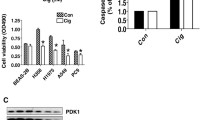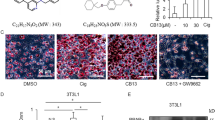Abstract
Peroxisome proliferator-activated receptor gamma (PPARγ) plays an important role in regulating energy balance, glucose and lipid metabolisms and inflammation. PPARγ also exerts multiple anti-cancer effects including tumor growth and angiogenesis inhibition, induction of cell differentiation, and apoptosis. Perturbed Wnt/β-catenin signaling likely plays a key role in tumorigenesis and the interaction between PPARγ and the transcriptional regulator β-catenin maybe important in this process. Phosphorylation of β-catenin by GSK-3β inactivates it and suppresses tumor cell proliferation and self-renewal of tumor stem cells. In combination with Frizzled, Wnt suppresses GSK-3β and causes degradation of β-catenin and activation of many tumor proliferation factors. In the present study, we investigated the effects of PPARγ agonist rosiglitazone (RGZ) and PPARγ antagonist GW9662 on the growth, mitotic cycle, and apoptosis of human lymphoma cell line, Raji cells. We also studied the influence of PPARγ ligands on the expression of β-catenin and GSK-3β in Raji cells to reveal whether Wnt/GSK-3β/β-catenin signaling pathways are involved in PPARγ ligands triggered Raji cell apoptosis. Results showed that both RGZ and GW9662 can inhibit the growth of Raji cells by inducing apoptosis and arresting cell cycle; however, there was no correlation between these effects and expression of PPARγ. Both the PPARγ ligands, RGZ and GW9662, appear to reciprocally regulate the mRNA and protein expressions of GSK-3β, which promotes apoptosis, and of β-catenin, which blocks apoptosis. These results suggest that PPARγ ligands mediate their effects via Wnt/GSK-3β/β-catenin signaling on Raji cell proliferation and survival.





Similar content being viewed by others
References
Blum, K. A., Lozanski, G., & Byrd, J. C. (2004). Adult Burkitt leukemia and lymphoma. Blood, 104, 3009–3020.
Issemann, I., & Green, S. (1990). Activation of a member of the steroid hormone receptor superfamily by peroxisome proliferators. Nature, 347, 645–650.
Bocher, V., Chinetti, G., Fruchart, J. C., & Staels, B. (2002). Role of the peroxisome proliferator-activated receptors (PPARS) in the regulation of lipids and inflammation control. Journal of Social Biology, 196, 47–52.
Ulivieri, C., & Baldari, C. T. (2007). The potential of peroxisome proliferator-activated receptor gamma (PPARgamma) ligands in the treatment of hematological malignancies. Mini Reviews in Medicinal Chemistry, 7, 877–887.
Wang, T., Xu, J., Yu, X., Yang, R., & Han, Z. C. (2006). Peroxisome proliferator-activated receptor gamma in malignant diseases. Critical Reviews in Oncology/Hematology, 58, 1–14.
Willson, T. M., Brown, P. J., Sternbach, D. D., & Henke, B. R. (2000). The PPARs: From orphan receptors to drug discovery. Journal of Medicinal Chemistry, 43, 527–550.
Konopleva, M., Elstner, E., McQueen, T. J., Tsao, T., Sudarikov, A., et al. (2004). Peroxisome proliferator-activated receptor gamma and retinoid X receptor ligands are potent inducers of differentiation and apoptosis in leukemias. Molecular Cancer Therapeutics, 3, 1249–1262.
Liu, H., Zang, C., Fenner, M. H., Liu, D., Possinger, K., et al. (2006). Growth inhibition and apoptosis in human Philadelphia chromosome-positive lymphoblastic leukemia cell lines by treatment with the dual PPARalpha/gamma ligand TZD18. Blood, 107, 3683–3692.
Ray, D. M., Akbiyik, F., & Phipps, R. P. (2006). The peroxisome proliferator-activated receptor gamma (PPARgamma) ligands 15-deoxy-Delta12, 14-prostaglandin J2 and ciglitazone induce human B lymphocyte and B cell lymphoma apoptosis by PPARgamma-independent mechanisms. Journal of Immunology, 177, 5068–5076.
Tabe, Y., Konopleva, M., Kondo, Y., Contractor, R., Tsao, T., et al. (2007). PPARgamma-active triterpenoid CDDO enhances ATRA-induced differentiation in APL. Cancer Biology & Therapy, 6, 1967–1977.
Read, W. L., Baggstrom, M. Q., Fracasso, P. M., & Govindan, R. (2008). A phase I study of bexarotene and rosiglitazone in patients with refractory cancers. Chemotherapy, 54, 236–241.
Rieger, M. E., Sims, A. H., Coats, E. R., Clarke, R. B., & Briegel, K. J. (2010). The embryonic transcription cofactor LBH is a direct target of the Wnt signaling pathway in epithelial development and in aggressive basal subtype breast cancers. Molecular and Cellular Biology, 30, 4267–4279.
Liu, X., Rubin, J. S., & Kimmel, A. R. (2005). Rapid, Wnt-induced changes in GSK3beta associations that regulate beta-catenin stabilization are mediated by Galpha proteins. Current Biology, 15, 1989–1997.
Takahashi-Yanaga, F., & Sasaguri, T. (2009). Drug development targeting the glycogen synthase kinase-3beta (GSK-3beta)-mediated signal transduction pathway: Inhibitors of the Wnt/beta-catenin signaling pathway as novel anticancer drugs. J Pharmacol Sci, 109, 179–183.
Meijer, L., Flajolet, M., & Greengard, P. (2004). Pharmacological inhibitors of glycogen synthase kinase 3. Trends in Pharmacological Sciences, 25, 471–480.
McNeill, H., & Woodgett, J. R. (2010). When pathways collide: Collaboration and connivance among signalling proteins in development. Nature Reviews Molecular Cell Biology, 11, 404–413.
Sopko, R., Silva, E., Clayton, L., Gardano, L., Barrios-Rodiles, M., et al. (2009). Phosphorylation of the tumor suppressor fat is regulated by its ligand Dachsous and the kinase discs overgrown. Current Biology, 19, 1112–1117.
Silva, E., Tsatskis, Y., Gardano, L., Tapon, N., & McNeill, H. (2006). The tumor-suppressor gene fat controls tissue growth upstream of expanded in the hippo signaling pathway. Current Biology, 16, 2081–2089.
Herbst, A., & Kolligs, F. T. (2007). Wnt signaling as a therapeutic target for cancer. Methods in Molecular Biology, 361, 63–91.
Reya, T., Duncan, A. W., Ailles, L., Domen, J., Scherer, D. C., et al. (2003). A role for Wnt signalling in self-renewal of haematopoietic stem cells. Nature, 423, 409–414.
Roman-Gomez, J., Cordeu, L., Agirre, X., Jimenez-Velasco, A., San Jose-Eneriz, E., et al. (2007). Epigenetic regulation of Wnt-signaling pathway in acute lymphoblastic leukemia. Blood, 109, 3462–3469.
Chim, C. S., Pang, R., Fung, T. K., Choi, C. L., & Liang, R. (2007). Epigenetic dysregulation of Wnt signaling pathway in multiple myeloma. Leukemia, 21, 2527–2536.
Fujisawa, T., Nakajima, A., Fujisawa, N., Takahashi, H., Ikeda, I., et al. (2008). Peroxisome proliferator-activated receptor gamma (PPARgamma) suppresses colonic epithelial cell turnover and colon carcinogenesis through inhibition of the beta-catenin/T cell factor (TCF) pathway. Journal of Pharmacological Sciences, 106, 627–638.
Seargent, J. M., Yates, E. A., & Gill, J. H. (2004). GW9662, a potent antagonist of PPARgamma, inhibits growth of breast tumour cells and promotes the anticancer effects of the PPARgamma agonist rosiglitazone, independently of PPARgamma activation. British Journal of Pharmacology, 143, 933–937.
Burton, J. D., Castillo, M. E., Goldenberg, D. M., & Blumenthal, R. D. (2007). Peroxisome proliferator-activated receptor-gamma antagonists exhibit potent antiproliferative effects versus many hematopoietic and epithelial cancer cell lines. Anticancer Drugs, 18, 525–534.
Jarrar, M. H., & Baranova, A. (2007). PPARgamma activation by thiazolidinediones (TZDs) may modulate breast carcinoma outcome: The importance of interplay with TGFbeta signalling. J Cell Mol Med, 11, 71–87.
Konturek, P. C., Kania, J., Konturek, J. W., Nikiforuk, A., Konturek, S. J., et al. (2003). H. pylori infection, atrophic gastritis, cytokines, gastrin, COX-2, PPAR gamma and impaired apoptosis in gastric carcinogenesis. Medical Science Monitor, 9, SR53–SR66.
Thompson, E. A. (2007). PPARgamma physiology and pathology in gastrointestinal epithelial cells. Molecules and Cells, 24, 167–176.
Eberhardt, N. L., Grebe, S. K., McIver, B., & Reddi, H. V. (2010). The role of the PAX8/PPARgamma fusion oncogene in the pathogenesis of follicular thyroid cancer. Molecular and Cellular Endocrinology, 321, 50–56.
Wahli, W. (2008). A gut feeling of the PXR, PPAR and NF-kappaB connection. Journal of Internal Medicine, 263, 613–619.
Zhang, X., & Young, H. A. (2002). PPAR and immune system—what do we know? International Immunopharmacology, 2, 1029–1044.
Ondrey, F. (2009). Peroxisome proliferator-activated receptor gamma pathway targeting in carcinogenesis: Implications for chemoprevention. Clinical Cancer Research, 15, 2–8.
Chen, Y. C., Shen, S. C., & Tsai, S. H. (2005). Prostaglandin D(2) and J(2) induce apoptosis in human leukemia cells via activation of the caspase 3 cascade and production of reactive oxygen species. Biochimica et Biophysica Acta, 1743, 291–304.
Konopleva, M., Tsao, T., Estrov, Z., Lee, R. M., Wang, R. Y., et al. (2004). The synthetic triterpenoid 2-cyano-3,12-dioxooleana-1,9-dien-28-oic acid induces caspase-dependent and -independent apoptosis in acute myelogenous leukemia. Cancer Research, 64, 7927–7935.
Liu, J. J., Huang, R. W., Lin, D. J., Peng, J., Wu, X. Y., et al. (2005). Expression of survivin and bax/bcl-2 in peroxisome proliferator activated receptor-gamma ligands induces apoptosis on human myeloid leukemia cells in vitro. Annals of Oncology, 16, 455–459.
Liu, J., Lu, H., Huang, R., Lin, D., Wu, X., et al. (2005). Peroxisome proliferator activated receptor-gamma ligands induced cell growth inhibition and its influence on matrix metalloproteinase activity in human myeloid leukemia cells. Cancer Chemotherapy and Pharmacology, 56, 400–408.
Bertram, J. S., & Vine, A. L. (2005). Cancer prevention by retinoids and carotenoids: Independent action on a common target. Biochimica et Biophysica Acta, 1740, 170–178.
Zand, H., Rahimipour, A., Salimi, S., & Shafiee, S. M. (2008). Docosahexaenoic acid sensitizes Ramos cells to Gamma-irradiation-induced apoptosis through involvement of PPAR-gamma activation and NF-kappaB suppression. Molecular and Cellular Biochemistry, 317, 113–120.
Lu, D., & Carson, D. A. (2010). Repression of beta-catenin signaling by PPAR gamma ligands. European Journal of Pharmacology, 636, 198–202.
Deshpande, A. J., & Buske, C. (2007). Knocking the Wnt out of the sails of leukemia stem cell development. Cell Stem Cell, 1, 597–598.
Gerhold, D. L., Liu, F., Jiang, G., Li, Z., Xu, J., et al. (2002). Gene expression profile of adipocyte differentiation and its regulation by peroxisome proliferator-activated receptor-gamma agonists. Endocrinology, 143, 2106–2118.
Author information
Authors and Affiliations
Corresponding authors
Additional information
Jia-Jun Liu, Xue-Jun Dai, and Yan Xu contributed equally to this study.
Rights and permissions
About this article
Cite this article
Liu, JJ., Dai, XJ., Xu, Y. et al. Inhibition of Lymphoma Cell Proliferation by Peroxisomal Proliferator-Activated Receptor-γ Ligands via Wnt Signaling Pathway. Cell Biochem Biophys 62, 19–27 (2012). https://doi.org/10.1007/s12013-011-9253-x
Published:
Issue Date:
DOI: https://doi.org/10.1007/s12013-011-9253-x




